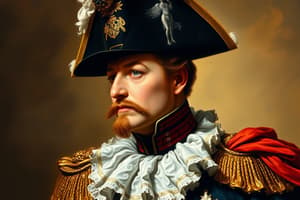Podcast
Questions and Answers
What is the title given to France by the papacy?
What is the title given to France by the papacy?
- Eldest son of the Church
- Eldest daughter of the Church (correct)
- Oldest daughter of the Church
- Oldest son of the Church
What period saw the Franks become the dominant power in Roman Gaul?
What period saw the Franks become the dominant power in Roman Gaul?
- Neolithic era
- Bronze Age
- Roman period
- 9th century (correct)
What was the main cause of the establishment of feudalism in France?
What was the main cause of the establishment of feudalism in France?
- Viking invasions
- Merovingian dynasty
- Roman Empire
- Private land ownership (correct)
Flashcards are hidden until you start studying
Study Notes
-
France is a country located in Western Europe.
-
It has a population of over 68 million people.
-
It is a unitary semi-presidential republic.
-
Its capital is Paris.
-
France's culture and language is heavily influenced by the Gallo-Roman period.
-
The French Revolution of 1789 overthrew the Ancien Régime and led to the Declaration of the Rights of Man.
-
France reached its political and military zenith under Napoleon Bonaparte.
-
Following Napoleon's defeat in 1815, France entered a period of relative decline.
-
The French Third Republic was established in 1870.
-
France is a country in Western Europe.
-
France has a long and rich history dating back to prehistoric times.
-
France has been through several wars in the past, most notably the Franco-Prussian War of 1870.
-
France is a developed country and is among the leading economies in the world.
-
The French language is spoken by a large majority of the population.
-
France is home to many UNESCO World Heritage Sites.
-
The French people are known for their culture and art.
-
France is located in Western Europe and is bordered by the English Channel to the north and the Mediterranean Sea to the south.
-
The Neolithic era began around 7,000 BC and the Bronze Age around 3,000 BC.
-
The Roman period began in 509 BC and ended in 476 AD.
-
The 5th century was a time of crisis for Roman Gaul, with barbarian invasions.
-
The 6th century was a time of revival and prosperity for Roman Gaul.
-
In the 5th century, Germanic tribes invaded Roman Gaul, and in the 6th century, the Franks settled in Roman Gaul.
-
In the 7th century, the Roman Empire was divided into several Germanic kingdoms.
-
In the 8th century, the Kingdom of Syagrius was established in Roman Gaul.
-
In the 9th century, the Franks became the dominant power in Roman Gaul.
-
In the 10th century, the Franks were replaced by the Normans.
-
Clovis I was the first Germanic conqueror after the fall of the Roman Empire to convert to Catholic Christianity, rather than Arianism; thus France was given the title "Eldest daughter of the Church" (French: La fille aînée de l'Église) by the papacy.
-
The Franks embraced the Christian Gallo-Roman culture and ancient Gaul was eventually renamed Francia ("Land of the Franks").
-
Clovis made Paris his capital and established the Merovingian dynasty, but his kingdom would not survive his death.
-
The Franks treated land purely as a private possession and divided it among their heirs, so four kingdoms emerged from that of Clovis: Paris, Orléans, Soissons, and Rheims.
-
During the 9th and 10th centuries, continually threatened by Viking invasions, France became a very decentralised state: the nobility's titles and lands became hereditary, and the authority of the king became more religious than secular and thus was less effective and constantly challenged by powerful noblemen.
-
Thus was established feudalism in France. Over time, some of the king's vassals would grow so powerful that they often posed a threat to the king.
Studying That Suits You
Use AI to generate personalized quizzes and flashcards to suit your learning preferences.




